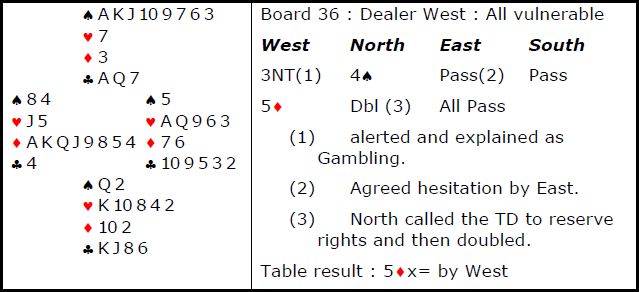 sign-off, then makes a 5
sign-off, then makes a 5 cuebid. He could easily have been thinking of passing, or conversely jumping to slam, so no action is suggested by the long pause.
cuebid. He could easily have been thinking of passing, or conversely jumping to slam, so no action is suggested by the long pause.
Law 16B1a says that when UI is available, "partner may not choose from among logical alternatives one that could demonstrably have been suggested over another by the extraneous information."
There has been some discussion within the Committee about the extent to which an action is demonstrably suggested. When a player hesitates, it could be for a number of reasons (not always bridge-related!). In some cases, it will not be obvious what the player was thinking about, and so no action is suggested over another by the UI. An example is where a player thinks over partner's 4 sign-off, then makes a 5
sign-off, then makes a 5 cuebid. He could easily have been thinking of passing, or conversely jumping to slam, so no action is suggested by the long pause.
cuebid. He could easily have been thinking of passing, or conversely jumping to slam, so no action is suggested by the long pause.
A type of sequence that has featured in a few appeals reviewed by the Committee is where a player hesitates over an opponent's game bid in competition, then passes. The TD/AC ruled that the player might have been thinking about doubling for penalties, and allowed partner to bid on as a sacrifice. The Committee felt that although this was theoretically possible, players with a borderline penalty double either passed smoothly, or actually made the double. A slow pass was felt, in practice, to usually be considering bidding on, and that this met the criteria for "demonstrably suggested".
An example of this type of ruling was appeal 13.070:

 bid. East’s slow pass was agreed by all at the table. The TD ruled that the hesitation by East had passed UI to West and that pass was a logical alternative action for West. (Laws 16B1a, 16B1b, 12C1a). TD ruling: 4
bid. East’s slow pass was agreed by all at the table. The TD ruled that the hesitation by East had passed UI to West and that pass was a logical alternative action for West. (Laws 16B1a, 16B1b, 12C1a). TD ruling: 4 + 1 by North.
+ 1 by North.
 .
.
 bid should have been disallowed.
bid should have been disallowed.
Although in this example, the TD got it right and the AC was wrong, this is an area where TDs need to consult with players more widely. Players will sometimes have differing views (from TDs, and from each other) on what is suggested by a hesitation.